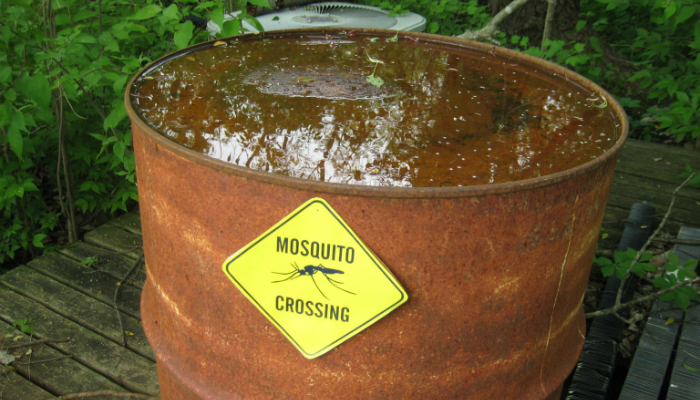If You Build it, They Will Come – Including Mosquitoes

Maine Blackfly Breeders Association members proudly proclaim their labors on bumper stickers. Iowa mosquito breeders are more humble publicly, but quietly work to protect their pets.
The combination of warm and wet weather has arrived, and in its wake we have morels and mosquitoes. Iowa has about 56 species of mosquitoes, most of them fairly innocuous. For example, the snowmelt mosquito (Aedes canadensis) sometimes breeds locally in puddles produced from melting snow in April. But their populations are small, and humans are well dressed or indoors then, so most people don’t even know they exist. Only about a half dozen species get pesky because of large numbers, or dangerous because they carry disease. Most species prefer breeding habitats that include water with a high organic content. On the farm, runoff from a manure pile into a tractor tire rut is perfection.
But even in suburbia, there are many microhabitats that you and/or your neighbors provide that can also score a ten, including:
- That vase of long-dead flowers on the porch.
- The sagging tarp over the woodpile holding rainwater.
- Clogged gutters with decaying leaves.
- Old tires containing rainwater.
- Untended birdbath with stagnant water and bird poop.
- Styrofoam cups, tin cans, plastic toys…
- The canoe lying on its side catching rainwater.
The list is long, and anything that holds a tiny puddle for two weeks in late spring or one week in the heat of summer is a candidate, including places completely out of sight. For example, many storm sewer inlets along the curb have a catch basin below to trap rocks and debris, but can also hold gallons of water. If someone supplements this with dog poop from the yard, it’s a mosquito factory down there. Some cities used to routinely spray diesel fuel down the storm sewers in summer to kill mosquito larvae, but this is hard on the receiving streams and their inhabitants, and I hope that the practice has ceased.
One of the most pesky mosquitoes in our area is the Asian tiger mosquito, also known as Vietnam’s Revenge, and it was imported in the US in 1985, probably in shipments of used tires. This is a bad-news species because it is large, bloodthirsty, prolific, bites by day, and displaces the native mosquito species – most of whom don’t bother us. Fortunately, Iowa’s winters are hard on this species, so its breeding habitat is usually in old tires. It is likely that the black tires heat up in the sun and provide higher water temperatures, a microclimate comparable to its native tropical habitat. An aggressive statewide chemical spraying program of tire storage areas has greatly reduced this species. However, states farther south are now a permanent home for these guys and they’ll be back at the first opportunity we provide. Therefore, we should avoid providing this opportunity – especially since these pests may also carry disease!
The most recent mosquito-borne threat to us is the Zika virus. The Iowa Department of Public Health anticipates that this will be a minor problem this year here in Iowa because its preferred mosquito host is largely a more southern species. But with all the little microhabitats we humans provide, plus a changing climate, our area could still meet their target zone criteria. There is also the possibility that some other mosquito species already established here will prove to be a carrier of Zika (we tend to ignore possibilities until a crisis is already upon us). The most likely candidate is Aedes albopictus, whose range already extends northward into central Minnesota.
Therefore, if someone in your neighborhood belongs to the Iowa Mosquito Breeders Association (“we breed them, you feed them”), you might benefit by encouraging them to cancel their membership.
But check your own yard first.


